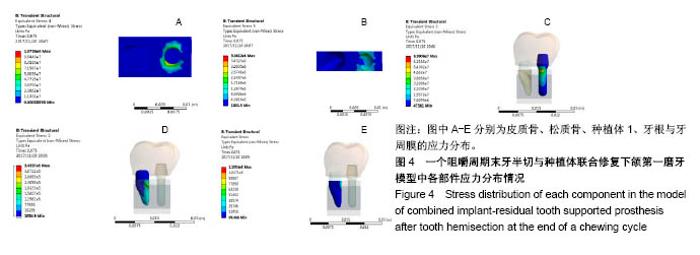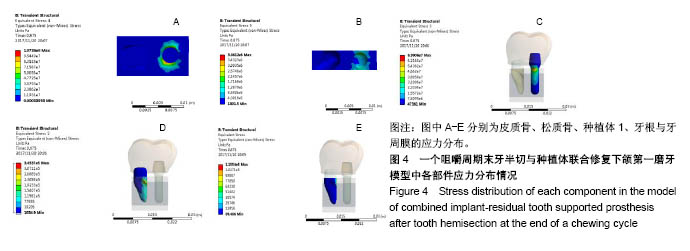Chinese Journal of Tissue Engineering Research ›› 2019, Vol. 23 ›› Issue (2): 178-183.doi: 10.3969/j.issn.2095-4344.1504
Previous Articles Next Articles
Three-dimensional finite element analysis of dental implant combined with residual tooth after hemisection under dynamic loads
Zou Yingnan, Wang Yibo, Ding Chao, Pan Xinyu, Shi Jiuhui
- Department of Stomatology, the First Affiliated Hospital of Harbin Medical University, Harbin 150010, Heilongjiang Province, China
-
Received:2018-07-21Online:2019-01-18Published:2019-01-18 -
Contact:Shi Jiuhui, Chief physician, Master’s supervisor, Department of Stomatology, the First Affiliated Hospital of Harbin Medical University, Harbin 150010, Heilongjiang Province, China -
About author:Zou Yingnan, Master candidate, Department of Stomatology, the First Affiliated Hospital of Harbin Medical University, Harbin 150010, Heilongjiang Province, China
CLC Number:
Cite this article
Zou Yingnan, Wang Yibo, Ding Chao, Pan Xinyu, Shi Jiuhui . Three-dimensional finite element analysis of dental implant combined with residual tooth after hemisection under dynamic loads[J]. Chinese Journal of Tissue Engineering Research, 2019, 23(2): 178-183.
share this article
Add to citation manager EndNote|Reference Manager|ProCite|BibTeX|RefWorks

2.2 不同修复模型的应力对比 种植体、皮质骨、松质骨应力分布情况:1个咀嚼周期末,牙半切与种植体联合修复模型>双种植体修复模型>单种植体修复模型。 种植体1应力对比:模型1的最大Von Mises应力值为628.22 MPa;模型2的最大Von Mises应力值为225.96 MPa;模型3的最大Von Mises应力值为371.96 MPa。3个模型中种植体的最大应力均集中于种植体颊侧颈缘与皮质骨交界处,且都在第Ⅳ阶段末获得。 皮质骨应力对比:模型1的最大Von Mises应力值为224.75 MPa,是在第Ⅳ阶段末于皮质骨与种植体远中颊侧颈缘交界处获得;模型2的最大Von Mises应力值为 82.558 MPa,是在第Ⅳ阶段末于皮质骨与种植体颊侧颈缘交界处获得;模型3的最大Von Mises应力值为109.68 MPa,是在第Ⅳ阶段末于种植体1的颊侧皮质骨处获得。 松质骨应力对比:模型1的最大Von Mises应力值为8.740 7 MPa,是在第Ⅳ阶段末于种植体近颈缘的舌侧松质骨处获得;模型2的最大Von Mises应力值为1.297 8 MPa,是在第Ⅳ阶段末于种植体远中颊侧颈缘与松质骨交界处获得;模型3的最大Von Mises应力值为4.807 9 MPa,是在第Ⅳ阶段末于种植体2的舌侧松质骨处获得。 2.3 疲劳实验结果 3个模型中安全系数最低的区域均为种植体与基台连接处,见图7,故预计种植体系统-骨组织首先在种植体颈部发生疲劳损坏。 模型1中种植体的使用寿命为1E013(1×1013),远大于种植体在口腔内受到的咀嚼压力次数,不会发生疲劳断裂现象。"

| [1] 陈虹,徒珂,欣田,等.牙半切除术联合固定修复保留患牙36例[J].实用医学杂志,2016,32(4):685-686.[2] Sharma S,Sharma R,Ahad A,et al.Hemisection as a Conservative Management of Grossly Carious Permanent Mandibular First Molar.J Nat Sci Biol Med.2018;9(1):97-99.[3] 陈俊良,何芸,黄跃.种植体联合牙半切剩余牙体共同支持下颌磨牙的三维有限元分析[J].中国组织工程研究, 2016,20(34):5027-5032. [4] 安倩.牙半切术的临床应用[J].口腔医学研究, 2013,29(10): 984-986.[5] He Y,Hasan I,Keilig L,et al.Combined implant-residual tooth supported prosthesis after tooth hemisection: A finite element analysis.Ann Anat.2016;206:96-103.[6] Heinemann F,Hasan I,Bourauel C,et al.Bone stability around dental implants: Treatment related factors.Ann Anat. 2015; 199(5):3-8.[7] 冯晓苏,吴桂萍,梁成文.超声骨刀与高速涡轮钻行下颌磨牙半切术临床效果观察[J].现代实用医学,2016,28(3):382-384.[8] Sharma S,Tewari RK,Mishra SK,et al.Conservative management of grossly carious mandibular first molar with a hemisection approach: a case report.Gen Dent. 2015;(4): 19-21.[9] Anitha S,Rao DS.Hemisection: A Treatment Option for an Endodontically treated Molar with Vertical Root Fracture.J Contemp Dent Pract.2015;16(2):163-165.[10] Babaji P,Sihag T,Chaurasia VR,et al.Hemisection:A conservative management of periodontally involved molar tooth in a young patient.J Nat Sci Biol Med.2015;(1):253-255.[11] 吕佳,刘翠玲,蓝菁,等.动态载荷下种植体位置和直径对悬臂梁种植固定义齿应力影响的三维有限元研究[J].华西口腔医学杂志, 2013,31(6):552-556.[12] 李晓宇,左雯鑫,朱啸,等.连续动态加载下单种植体周围骨组织应力的三维有限元分析[J].实用口腔医学杂志,2011,27(1):26-29.[13] Kayabas O,Yuzbasoglu E,Erzincanl F.Static, dynamic and fatigue behaviors of dental implant using finite element method. Adv Eng Software.2006;37(10):649-658. [14] 张杨,王超,张晓南,等.动态载荷下不同骨质对天然牙-种植体联合修复应力分布的影响[J].华西口腔医学杂志, 2015,33(3): 286-290.[15] Bouazza-Juanes K,Martínez-González A,Peiró G,et al.Effect of platform switching on the peri-implant bone: A finite element study.J Clin Exp Dent.2015;7(4):e483-488.[16] Bouazza-Juanes K,Martínez-González A,Peiró G,et al.Effect of platform switching on the peri-implant bone: A finite element study.J Clin Exp Dent.2015;7(4):e483-488.[17] 高飞,张恩维,魏世成,等.种植体螺纹结构及接触面静力和疲劳分析[J].中国组织工程研究与临床康复,2010,14(30):5531-5534.[18] 赵吉奎.牙种植体系统的生物力学有限元分析[D].沈阳:东北大学, 2012.[19] Davis SM,Plonka AB,Wang HL.Risks and benefits of connecting an implant and natural tooth.Implant Dent. 2014; 23(3):253-257.[20] 崇阳阳,丁超,王屹博,等.种植体联合牙半切术单冠修复下颌第一磨牙三维有限元分析[J].哈尔滨医科大学学报, 2016,50(2): 170-173.[21] Anitua E,Tapia R,Luzuriaga F,et al.Influence of implant length, diameter, and geometry on stress distribution: a finite element analysis.Int J Periodontics Restorative Dent. 2010;30(1):89-95.[22] 郭莹,唐亮,潘燕环.动态载荷下单端桥基牙牙周膜应力的三维有限元分析[J].中华口腔医学杂志, 2009,44(9):553-557.[23] He Y,Hasan I,Chen J,et al.The influence of residual root number and bone density on combined implant-residual tooth supported prosthesis after tooth hemisection: A finite element study.Ann Anat.2016;208:103-108. [24] Naveen YG,Patel JR,Parikh P,et al.Alternatives for restoration of a hemisected mandibular molar.BMJ Case Rep. 2014;30(7):75.[25] 卢熹,杨瑛.下颌骨-牙种植体有限元建模与瞬态分析[J].东南大学学报,2010,40(4):722-725.[26] 丁存善,王荃,徐小红.磨牙半切除术后与邻牙联冠修复的临床疗效[J].口腔医学,2015,35(5):386-388.[27] 李景辉,陈光宇,张方明.种植体联合牙半切术单冠修复下颌磨牙的疗效观察[J].北京口腔医学,2012,20(6):334-337.[28] Rittel D,Shemtov-Yona K,Lapovok R.Random spectrum fatigue performance of severely plastically deformed titanium for implant dentistry applications.J Mech Behav Biomed Mater. 2018;83:94-101.[29] Stefanini M,Felice P,Mazzotti C,et al.Esthetic evaluation and patient-centered outcomes in single-tooth implant rehabilitation in the esthetic area.Periodontol 2000.2018;77(1):150-164.[30] 王姝,李琼金,武龙.有限元法在口腔种植领域的研究进展[J].中华老年口腔医学杂志,2018,17(2):125-128.[31] 潘勇.口腔种植牙生物力学研究进展[J].全科口腔医学电子杂志, 2018,5(1):12-13.[32] Al-Jewair TS,Swiderski B.Orthodontic Canine Substitution for the Management of Missing Maxillary Lateral Incisors May Have Superior Periodontal and Esthetic Outcomes Compared to an Implant- or Tooth-Supported Prosthesis.J Evid Based Dent Pract 2018;18(2):153-156.[33] Soliman TA,Tamam RA,Yousief SA,et al. El-Anwar. Assessment of stress distribution around implant fixture with three different crown materials.Tanta Dental J.2015;12:249.[34] Jeong HS,Sung SJ,Moon YS,et al.Factors influencing the axes of anterior teeth during SWA en masse sliding retraction with orthodonticmini-implant anchorage:a finite element study.Korean J Orthod.2006;36:339-348.[35] 都吉秀,叶平,吴润发,等.双根单冠种植修复下颌第一磨牙的三维有限元分析[J].中国口腔种植学杂志,2008,13(1):1-5.[36] De Paula GA,Silva GC,Vilaca EL,et al.Biomechanical Behavior of Tooth-Implant Supported Prostheses With Different Implant Connections: A Nonlinear Finite Element Analysis.Implant Dent. 2018.doi: 10.1097/ID.0000000000000737.[Epub ahead of print][37] Rasouli-Ghahroudi AA,Geramy A,Yaghobee S,et al. Evaluation of Platform Switching on Crestal Bone Stress in Tapered and Cylindrical Implants: A Finite Element Analysis.J Int Acad Periodontol. 2015;17(1):2-13.[38] 陶江丰,陈宁,顾卫平,等.不同直径和数目种植体支持修复下颌第一磨牙的有限元分析[J].口腔医学,2009,29(10):522-524.[39] 李晓宇,左雯鑫,朱啸,等.连续动态加载下单种植体周围骨组织应力的三维有限元分析[J].实用口腔医学杂志,2011,27(1):26-28.[40] Clelland NL,Ismail YH,Zaki HS,et al.Three-dimensional finite element stress analysis in and around the Screw- Vent implant.Int J Oral Maxillofac Implants.1991;6(4):391-398.[41] 韩雪莲,刘宗伟,李岩涛.种植牙即刻负重的生物力学的三维有限元分析[J].华西口腔医学杂志,2011, 29(2):121-124.[42] 武常亮,周延民,龚学庆.单、双种植体修复下颌第一磨牙载荷状态下种植体周围组织应变及受力的实验研究[J].现代口腔医学杂志,2006,20(4):388-390.[43] Gehrke SA,Pérez-Albacete Martínez C,Piattelli A,et al.The influence of three different apical implant designs at stability and osseointegration process:experimental study in rabbits. Clin Oral Implants Res.2017;28(3):355-361. [44] Valente ML,de Castro DT,Shimano AC,et al.Analysis of the influence of implant shape on primary stability using the correlation of multiple methods.Clin Oral Investig. 2015;19(8): 1861-1866. |
| [1] | Zhang Tongtong, Wang Zhonghua, Wen Jie, Song Yuxin, Liu Lin. Application of three-dimensional printing model in surgical resection and reconstruction of cervical tumor [J]. Chinese Journal of Tissue Engineering Research, 2021, 25(9): 1335-1339. |
| [2] | Chen Xinmin, Li Wenbiao, Xiong Kaikai, Xiong Xiaoyan, Zheng Liqin, Li Musheng, Zheng Yongze, Lin Ziling. Type A3.3 femoral intertrochanteric fracture with augmented proximal femoral nail anti-rotation in the elderly: finite element analysis of the optimal amount of bone cement [J]. Chinese Journal of Tissue Engineering Research, 2021, 25(9): 1404-1409. |
| [3] | Zeng Yanhua, Hao Yanlei. In vitro culture and purification of Schwann cells: a systematic review [J]. Chinese Journal of Tissue Engineering Research, 2021, 25(7): 1135-1141. |
| [4] | Cai Qunbin, Zou Xia, Hu Jiantao, Chen Xinmin, Zheng Liqin, Huang Peizhen, Lin Ziling, Jiang Ziwei. Relationship between tip-apex distance and stability of intertrochanteric femoral fractures with proximal femoral anti-rotation nail: a finite element analysis [J]. Chinese Journal of Tissue Engineering Research, 2021, 25(6): 831-836. |
| [5] | Song Chengjie, Chang Hengrui, Shi Mingxin, Meng Xianzhong. Research progress in biomechanical stability of lateral lumbar interbody fusion [J]. Chinese Journal of Tissue Engineering Research, 2021, 25(6): 923-928. |
| [6] | Liu Zhao, Xu Xilin, Shen Yiwei, Zhang Xiaofeng, Lü Hang, Zhao Jun, Wang Zhengchun, Liu Xuzhuo, Wang Haitao. Guiding role and prospect of staging and classification combined collapse prediction method for osteonecrosis of femoral head [J]. Chinese Journal of Tissue Engineering Research, 2021, 25(6): 929-934. |
| [7] | Xu Dongzi, Zhang Ting, Ouyang Zhaolian. The global competitive situation of cardiac tissue engineering based on patent analysis [J]. Chinese Journal of Tissue Engineering Research, 2021, 25(5): 807-812. |
| [8] | Wu Zijian, Hu Zhaoduan, Xie Youqiong, Wang Feng, Li Jia, Li Bocun, Cai Guowei, Peng Rui. Three-dimensional printing technology and bone tissue engineering research: literature metrology and visual analysis of research hotspots [J]. Chinese Journal of Tissue Engineering Research, 2021, 25(4): 564-569. |
| [9] | Chang Wenliao, Zhao Jie, Sun Xiaoliang, Wang Kun, Wu Guofeng, Zhou Jian, Li Shuxiang, Sun Han. Material selection, theoretical design and biomimetic function of artificial periosteum [J]. Chinese Journal of Tissue Engineering Research, 2021, 25(4): 600-606. |
| [10] | Liu Fei, Cui Yutao, Liu He. Advantages and problems of local antibiotic delivery system in the treatment of osteomyelitis [J]. Chinese Journal of Tissue Engineering Research, 2021, 25(4): 614-620. |
| [11] | Li Xiaozhuang, Duan Hao, Wang Weizhou, Tang Zhihong, Wang Yanghao, He Fei. Application of bone tissue engineering materials in the treatment of bone defect diseases in vivo [J]. Chinese Journal of Tissue Engineering Research, 2021, 25(4): 626-631. |
| [12] | Zhang Zhenkun, Li Zhe, Li Ya, Wang Yingying, Wang Yaping, Zhou Xinkui, Ma Shanshan, Guan Fangxia. Application of alginate based hydrogels/dressings in wound healing: sustained, dynamic and sequential release [J]. Chinese Journal of Tissue Engineering Research, 2021, 25(4): 638-643. |
| [13] | Chen Jiana, Qiu Yanling, Nie Minhai, Liu Xuqian. Tissue engineering scaffolds in repairing oral and maxillofacial soft tissue defects [J]. Chinese Journal of Tissue Engineering Research, 2021, 25(4): 644-650. |
| [14] | Chen Lu, Zhang Jianguang, Deng Changgong, Yan Caiping, Zhang Wei, Zhang Yuan. Finite element analysis of locking screw assisted acetabular cup fixation [J]. Chinese Journal of Tissue Engineering Research, 2021, 25(3): 356-361. |
| [15] | Xing Hao, Zhang Yonghong, Wang Dong. Advantages and disadvantages of repairing large-segment bone defect [J]. Chinese Journal of Tissue Engineering Research, 2021, 25(3): 426-430. |
| Viewed | ||||||
|
Full text |
|
|||||
|
Abstract |
|
|||||





